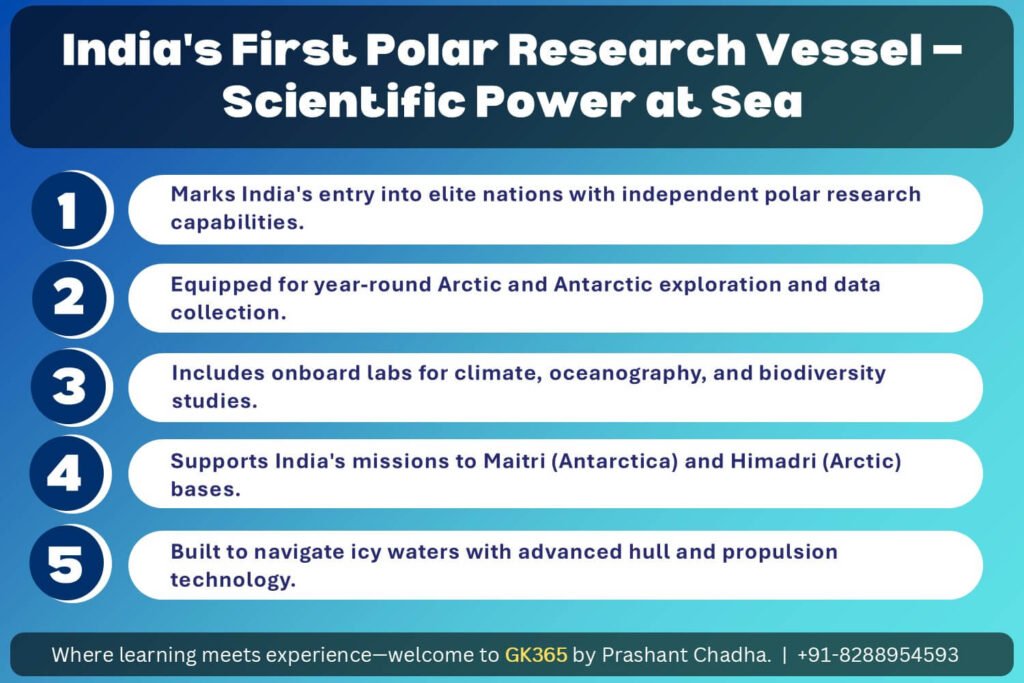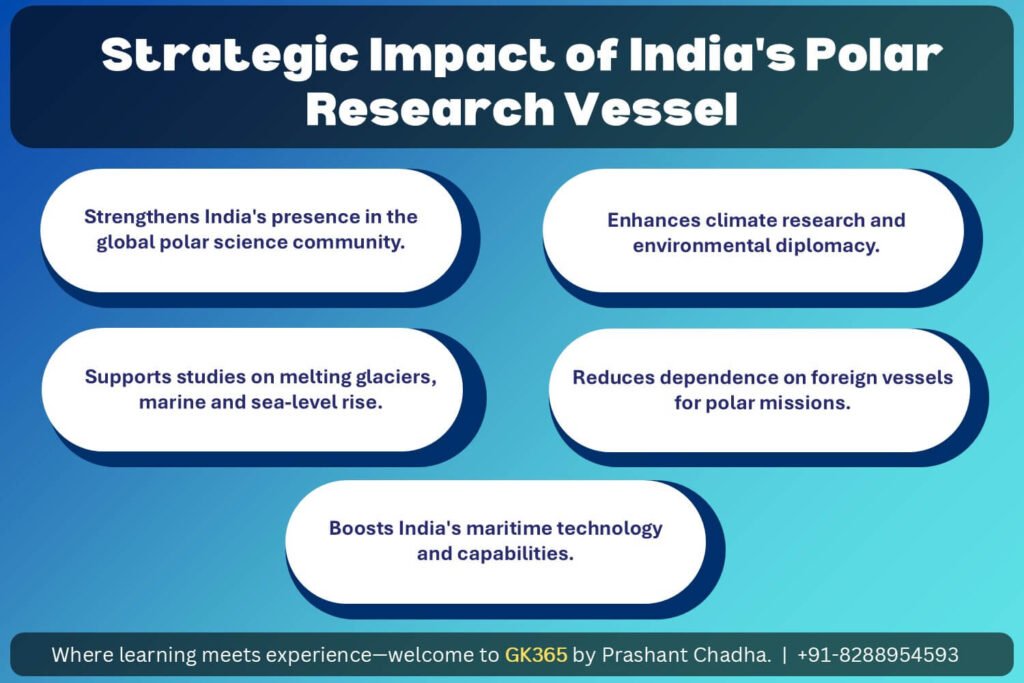India is building its first indigenously made Polar Research Vessel (PRV). The effort is part of a partnership between Garden Reach Shipbuilders and Engineers Ltd. (GRSE) and Norway’s Kongsberg. It strengthens both India’s polar research and its domestic shipbuilding capacity.
This step moves India closer to becoming a key player in polar science, ocean research, and clean maritime technology.
Table of Contents
- Why in News?
- Background: India’s Polar Research Journey
- About the MoU & Polar Research Vessel
- Purpose and Features of the PRV
- MAHASAGAR Vision and India’s Maritime Strategy
- India-Norway Cooperation: Key Highlights
- Significance: Why the PRV Matters
- Future Prospects & Global Role
- FAQs
- Conclusion
- Key Takeaways Table
Why in News?
On June 3, 2025, Union Minister Sarbananda Sonowal witnessed the signing of an agreement between GRSE and Kongsberg. This Memorandum of Understanding (MoU) lays the groundwork for building India’s first Polar Research Vessel.
The ship will support polar and ocean studies, guided by the National Centre for Polar and Ocean Research (NCPOR).
Background: India’s Polar Research Journey
India has taken part in polar research for decades. But until now, it has relied on foreign ships for its missions.
Key Developments:
- NCPOR, based in Goa, runs India’s polar and ocean programs.
- India set up its first Antarctic base, Dakshin Gangotri, in 1983. It was followed by Maitri and Bharati.
- The new vessel will allow year-round research trips with full Indian control.
About the MoU & Polar Research Vessel
Who Signed the MoU:
- GRSE (India): A Kolkata-based shipbuilder known for complex naval vessels.
- Kongsberg (Norway): A global provider of marine technology and digital systems.
Project Goals:
- Design and build India’s first Polar Research Vessel.
- Equip the ship with ice-navigation tools, ocean sensors, and onboard labs.
Broader Aims:
- Promote Make in India and Atmanirbhar Bharat.
- Expand India’s polar research.
- Deepen India-Norway ties in sustainable shipping.
Purpose and Features of the PRV
The vessel will serve as a research base and operations hub in polar waters. Key features include:
- Deep-Sea Mapping: Tools for ocean floor surveys.
- Climate Monitoring: Equipment to study glaciers and ice conditions.
- Marine Biology Labs: Facilities to monitor ecosystems and wildlife.
- Ice-Ready Design: Reinforced structure to move through thick ice.
- Smart Navigation: Digital systems for safe operations in polar zones.
MAHASAGAR Vision and India’s Maritime Strategy
This project fits into India’s MAHASAGAR vision—Mutual and Holistic Advancement for Security Across the Regions. It extends the broader SAGAR plan for regional growth and safety.
Focus Areas:
- Stronger maritime security.
- Greener, more digital shipbuilding.
- Sustainable use of ocean resources.
India-Norway Cooperation: Key Highlights
At the Nor-Shipping 2025 summit, Minister Sonowal met with Norway’s Shipowners’ Association.
Outcomes:
- Invited investments in green shipping.
- Showcased India as a major provider of global seafarers.
- Promoted India’s ship recycling sector, where 87% of yards meet international standards.
Significance: Why the PRV Matters
- Research Boost: Supports India’s climate and polar science goals.
- Strategic Reach: Expands India’s presence in Arctic and Antarctic regions.
- Industry Growth: Creates jobs in shipbuilding and related sectors.
- Eco-Focus: Encourages cleaner and smarter shipping practices.
Future Prospects & Global Role
The PRV will help:
- Strengthen India’s place in climate talks.
- Enable joint missions with other countries.
- Drive new ship technologies and ocean research tools.
FAQs
- Why is India building a Polar Research Vessel?
To support its own polar studies, upgrade research tools, and reduce reliance on foreign ships. - Who is involved in the project?
GRSE (India), Kongsberg (Norway), and NCPOR (India’s polar research agency). - What will the vessel do?
Support expeditions, climate research, and deep-sea studies. - How does this relate to Make in India?
The ship will be built in India, boosting local industry and jobs. - When will the PRV be ready?
The timeline is not fixed yet. Construction will begin after the design is final.
Conclusion
India’s first Polar Research Vessel is more than just a ship. It is a step toward scientific self-reliance and cleaner maritime practices. By combining global partnerships with Indian manufacturing, the country is preparing for a bigger role in global ocean and climate research.
👉 Learn more about India’s science and ocean missions at GK365.in. Stay informed.
Key Takeaways Table
| Category | Details |
|---|---|
| Project Name | India’s First Polar Research Vessel (PRV) |
| Announced On | June 3, 2025, during the Nor-Shipping Summit |
| Partnership | – GRSE (India) – Garden Reach Shipbuilders and Engineers Ltd.- Kongsberg (Norway) – Marine tech leader |
| Coordinating Body | NCPOR (National Centre for Polar and Ocean Research) |
| Purpose | To conduct polar and deep-sea research; reduce reliance on foreign vessels |
| Key Features | – Ice-strengthened hull- Deep-sea mapping tools- Marine biology labs- Smart navigation systems- Climate monitoring systems |
| Strategic Fit | Aligns with MAHASAGAR Vision under SAGAR maritime strategy – for regional security, clean tech, and shipbuilding growth |
| Significance | – Boosts India’s polar science and shipbuilding capacity– Enhances Arctic and Antarctic presence– Supports Make in India |
| India-Norway Cooperation | – Green shipping promotion- Ship recycling leadership- Joint R&D in ocean tech |
| Expected Benefits | – Maritime jobs- Strategic reach- Ocean research tools- Global climate collaboration |
| Timeline Status | Construction to begin after design finalization; timeline not officially confirmed |



